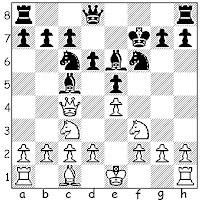Here is a recent Jerome Gambit (1.e4 e5 2.Nf3 Nc6 3.Bc4 Bc5 4.Bxf7+ Kxf7) game by Bill Wall.
Why does Bill play the Jerome?
I have quoted Willie Sutton before: When he was asked why he robbed banks, he said, “Because that's where the money is.”
Why does Bill play the Jerome Gambit?
Because that is where the points are. In over 1,150 Jerome Gambit games in The Database, he has scored 94%.
Wall, Bill - Kumar
internet, 2023
1.e4 e5 2.Nf3 Nc6 3.Bc4 Bc5 4.Bxf7+ Kxf7
5.Nc3
Delaying the second Jerome sacrifice.
5...h6
Transposing to a Semi-Italian Jerome Gambit.
White gains more from his 5th move than Black gains from his.
Bill has also seen 5...d6 6.O-O (6.d3 h6 7.Na4 Bb4+ 8.c3 Ba5 9.O-O Nf6 10.h3 b5 11.Qb3+ d5 12.Qxb5 Qd6 13.exd5 Qxd5 14.Qxc6 Qxc6 15.Nxe5+ Ke6 16.Nxc6 Bb6 17.Bf4 Nd5 18.Rfe1+ Kf5 19.Re5+ Kxf4 20.g3+ Kf3 21.Nxb6 axb6 22.Nd4 checkmate, Wall,B - Guest190971, PlayChess.com 2020) 6...Bg4 7.d3 Nd4 8.Nxe5+ dxe5 9.Qxg4 Nf6 10.Qd1 c6 11.Na4 Bd6 12.Be3 Ne6 13.Qd2 Qc7 14.Nc3 Rad8 15.Ne2 Rhf8 16.Qc3 Kg8 17.Qb3 Rde8 18.Bxa7 Kh8 19.Be3 Ng4 20.Bb6 Qb8 21.h3 Nf6 22.Ng3 Nd4 23.Qc4 Nd7 24.Bxd4 exd4 25.Qxd4 c5 26.Qa4 Rd8 27.Nf5 Nb6 28.Qb5 Qc7 29.Ne3 Qc6 30.Qxc6 bxc6 31.a4 Ra8 32.a5 Nd7 33.Nc4 Be7 34.e5 Rfb8 35.b3 h6 36.f4 Bd8 37.a6 Nb6 38.Na5 Rxa6 39.Nxc6 Rxa1 40.Rxa1 Rc8 41.Nxd8 Rxd8 42.Ra5 Ra8 43.Rxc5 Ra2 44.c4 Rd2 45.e6 Rxd3 46.e7 Re3 47.Re5 Black resigned, Wall,B - Rahman,N, Chess.com 2010; or
5...Nf6 6.Qe2 (6.d3 Re8 7.Bg5 d6 8.O-O Nd4 9.Nxd4 Bxd4 10.Nd5 Be6 11.c3 Bxd5 12.cxd4 Bc6 13.d5 Bd7 14.f4 Kg8 15.Qb3 Qc8 16.fxe5 Rxe5 17.Bxf6 gxf6 18.Rxf6 b6 19.Raf1 Qb7 20.Rf7 Bg4 21.Qc2 Rc8 22.Qf2 Qb8 23.Qf6 Black resigned, Wall,B - Benjamin, internet, 2023) 6...Rf8 (6...d6 7.Na4 Nb4 8.Qc4+ Ke8 9.a3 b6 10.axb4 Bxb4 11.Qxb4 Bg4 12.Nc3 c6 13.d4 d5 14.Nxe5 Black resigned, Wall,B - Guest153817, PlayChess.com 2018) 7.Qc4+ Ke8 8.Qxc5 d6 9.Qc4 Qe7 10.d4 exd4 11.Nxd4 Nxe4 12.Nxc6 Qh4 13.O-O Rxf2 14.Nxe4 Rxg2+ 15.Kxg2 Bh3+ 16.Kh1 Qg4 17.Qf7 checkmate, Wall,B - Roberts,C, Chess.com, 2010.
6.Nxe5+ Nxe5 7.Qh5+ Ke6
Bill has also faced 7...Ng6 8.Qd5+ Kf8 (8...Ke8 9.Qxc5 d6 10.Qa3 N8e7 11.O-O Nh4 12.d4 Neg6 13.f4 Rf8 14.Be3 Bg4 15.Qb3 Rb8 16.f5 Ne7 17.Bf2 Nexf5 18.exf5 Nxf5 19.Rae1+ Kd7 20.Qe6+ Kc6 21.d5 checkmate, Wall,B - Mbgmx, Chess.com 2010) 9.Qxc5+ N8e7 10.f4 d6 11.Qf2 Nc6 12.d4 Qh4 13.g3 Qh3 14.f5 Nge7 15.f6 Nf5 16.exf5 Bxf5 17.fxg7+ Kxg7 18.Nd5 Rhf8 19.Nf4 Rae8+ 20.Be3 Qg4 21.h3 Qg5 22.O-O-O Nb4 23.Qd2 Qxg3 24.Nh5+ Black resigned, Wall,B - Jllib976, Chess.com 2010.
8.Qf5+ Kd6 9.b4 Bb6
Or 9...Bxb4 10.Nb5+ Kc6 11.Nxd4+ Kd6 12.Nb5+ Kc6 13.Qxe5 d6 14.Nd4+ Kd7 15.Qe6 checkmate as in Wall,B - My10, 2017.
10.f4 Qf6
Sometimes Black's Queen belongs on f6, sometimes not.
Today, not.
11.fxe5+ Qxe5 12.Nb5+ Black resigned
Black's Queen is about to be robbed of her support.


.png)
.png)
.png)











































